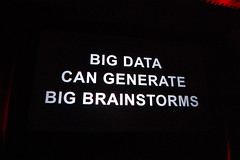
GOOD with numbers? Fascinated by data? The sound you hear is opportunity knocking.
Mo Zhou was snapped up by I.B.M. last summer, as a freshly minted Yale M.B.A., to join the technology company’s fast-growing ranks of data consultants. They help businesses make sense of an explosion of data — Web traffic and social network comments, as well as software and sensors that monitor shipments, suppliers and customers — to guide decisions, trim costs and lift sales. “I’ve always had a love of numbers,” says Ms. Zhou, whose job as a data analyst suits her skills.
To exploit the data flood, America will need many more like her. A report last year by the McKinsey Global Institute, the research arm of the consulting firm, projected that the United States needs 140,000 to 190,000 more workers with “deep analytical” expertise and 1.5 million more data-literate managers, whether retrained or hired.
The impact of data abundance extends well beyond business. Justin Grimmer, for example, is one of the new breed of political scientists. A 28-year-old assistant professor at Stanford, he combined math with political science in his undergraduate and graduate studies, seeing “an opportunity because the discipline is becoming increasingly data-intensive.” His research involves the computer-automated analysis of blog postings, Congressional speeches and press releases, and news articles, looking for insights into how political ideas spread.
The story is similar in fields as varied as science and sports, advertising and public health — a drift toward data-driven discovery and decision-making. “It’s a revolution,” says Gary King, director of Harvard’s Institute for Quantitative Social Science. “We’re really just getting under way. But the march of quantification, made possible by enormous new sources of data, will sweep through academia, business and government. There is no area that is going to be untouched.”
Welcome to the Age of Big Data. The new megarich of Silicon Valley, first at Google and now Facebook, are masters at harnessing the data of the Web — online searches, posts and messages — with Internet advertising. At the World Economic Forum last month in Davos, Switzerland, Big Data was a marquee topic. A report by the forum, “Big Data, Big Impact,” declared data a new class of economic asset, like currency or gold.
Rick Smolan, creator of the “Day in the Life” photography series, is planning a project later this year, “The Human Face of Big Data,” documenting the collection and uses of data. Mr. Smolan is an enthusiast, saying that Big Data has the potential to be “humanity’s dashboard,” an intelligent tool that can help combat poverty, crime and pollution. Privacy advocates take a dim view, warning that Big Data is Big Brother, in corporate clothing.
What is Big Data? A meme and a marketing term, for sure, but also shorthand for advancing trends in technology that open the door to a new approach to understanding the world and making decisions. There is a lot more data, all the time, growing at 50 percent a year, or more than doubling every two years, estimates IDC, a technology research firm. It’s not just more streams of data, but entirely new ones. For example, there are now countless digital sensors worldwide in industrial equipment, automobiles, electrical meters and shipping crates. They can measure and communicate location, movement, vibration, temperature, humidity, even chemical changes in the air.
Link these communicating sensors to computing intelligence and you see the rise of what is called the Internet of Things or the Industrial Internet. Improved access to information is also fueling the Big Data trend. For example, government data — employment figures and other information — has been steadily migrating onto the Web. In 2009, Washington opened the data doors further by starting Data.gov, a Web site that makes all kinds of government data accessible to the public.
Data is not only becoming more available but also more understandable to computers. Most of the Big Data surge is data in the wild — unruly stuff like words, images and video on the Web and those streams of sensor data. It is called unstructured data and is not typically grist for traditional databases.
But the computer tools for gleaning knowledge and insights from the Internet era’s vast trove of unstructured data are fast gaining ground. At the forefront are the rapidly advancing techniques of artificial intelligence like natural-language processing, pattern recognition and machine learning.
Read more . . .
Bookmark this page for “big data” and check back regularly as these articles update on a very frequent basis. The view is set to “news”. Try clicking on “video” and “2” for more articles.







